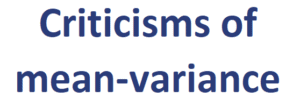Criticisms of mean-variance optimization (MVO)
Mean-variance optimization, proposed by Harry Markowitz in the early 1950s, is one of the cornerstones of modern finance. While the theory is quite elegant and makes intuitive sense, there are nevertheless a number of criticisms of mean-variance optimization that are worth highlighting. On this page, we discuss 6 criticisms of MVO. These shortcomings are important when using MVO. That way, we are aware of the limitations of the approach
MVO criticisms
- GIGO: garbage in, garbage out. This means that the output of MVO is highly sensitive to the quality of the inputs (i.e. the expected returns, variance, and correlations). This is sometimes referred to as the garbage-in-garbage-out problem. While all three components lead to estimation error, it is especially the expected returns that may have a particularly large impact on the results.
- Concentrated asset class allocations. MVO often identifies efficient portfolios that are highly concentrated in a subset of asset classes, with no allocation to other asset classes. Thus, the lowest calculated standard deviation is not the same as practical diversification.
- Skewness and kurtosis. MVO does not look at skewness and kurtosis. The reason is that it only looks at the first two moments of the distribution, i.e. the mean and the variance. Empirical evidence, however, suggests that asset returns are not normally distributed. In fact, asset returns tend to exhibit excess kurtosis and negative skewness
- Risk diversification. MVO identifies an asset allocation diversified across asset classes that is not necessarily diversified across sources of risk. For example, equities and fixed income securities are two different asset classes, but they are driven by some common risk factor.
- Ignores liabilities. MVO does not take into consideration the fact that investors sometimes create portfolios as a source of cash to pay for something in the future. A more robust approach would take the factors that impact liabilities into account and the correlations between changes in value of the liabilities and returns on the asset portfolio.
- Single-period framework: MVO is a single-period framework that does not take into account interim cash flows or serial correlation. As a consequence, it ignores the potential costs and benefits or rebalancing the portfolio as market conditions change and asset allocations drift away from the optimal weights.

